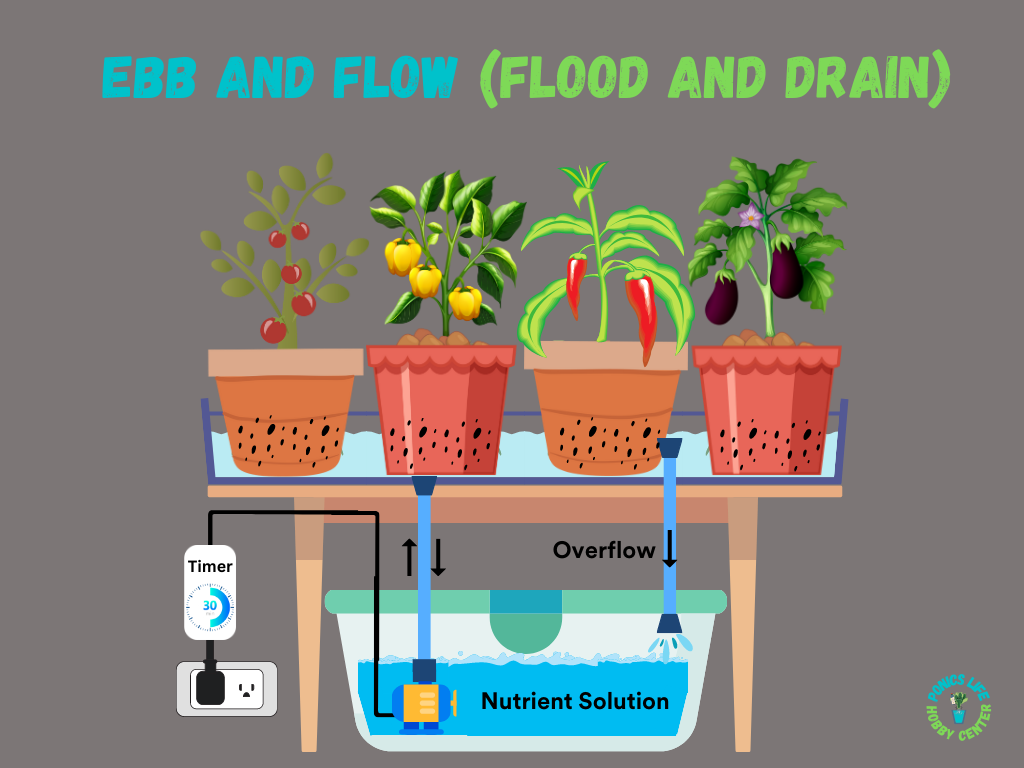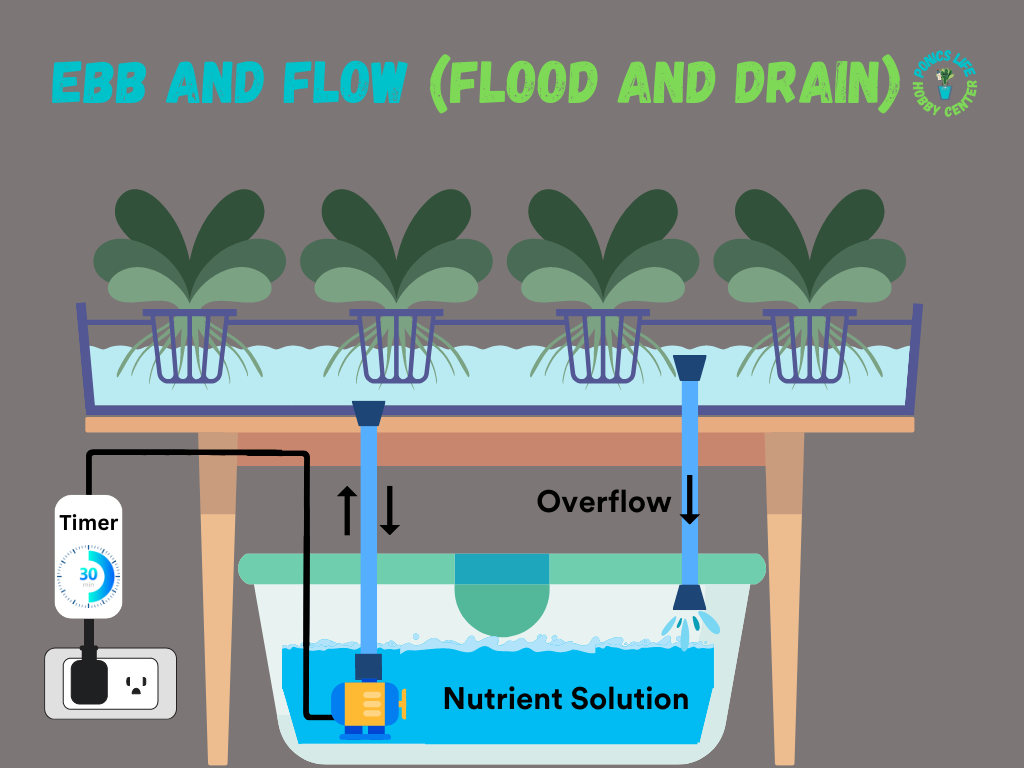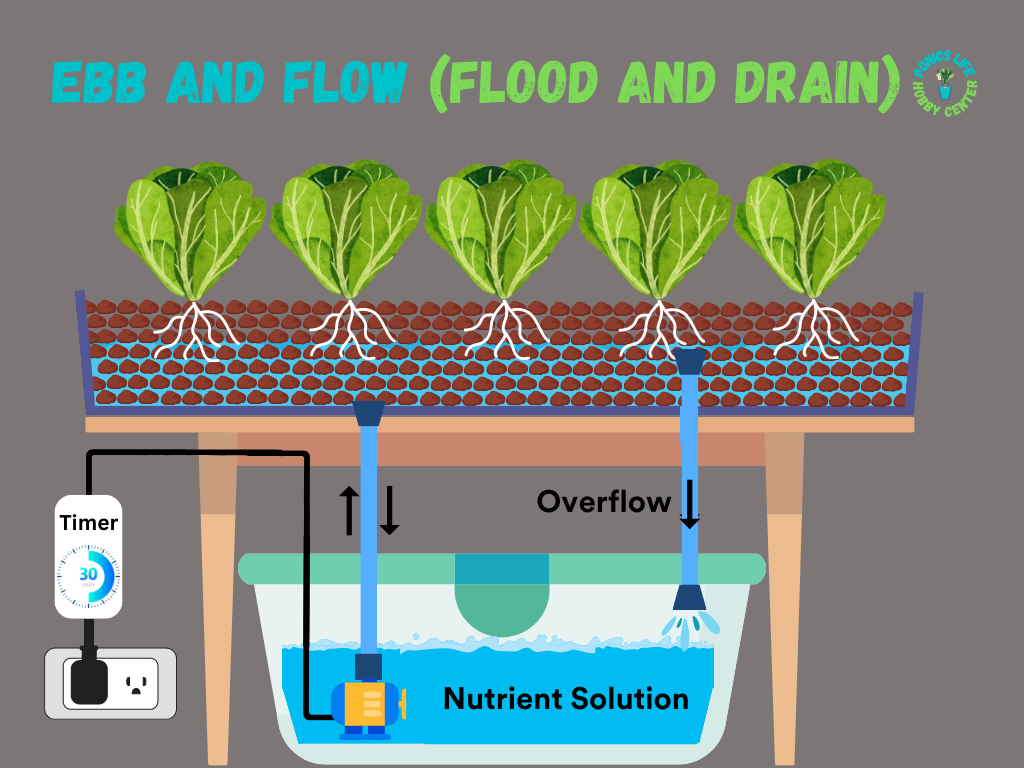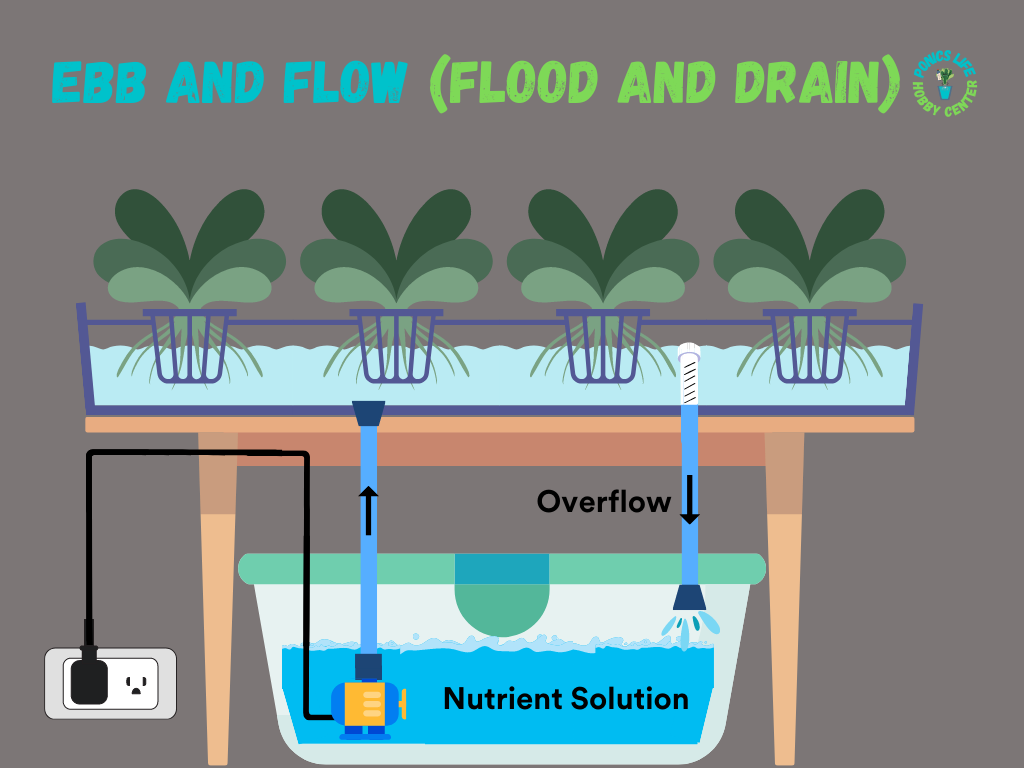Ebb and flow hydroponics, also known as flood and drain hydroponics, is a type of hydroponic system that utilizes a water pump to periodically flood your plant roots with nutrient-rich water, and then drain the water away. This process is repeated multiple times throughout the day, depending on the specific needs of the plants being grown.
The ebb and flow system is made up of several components, including a water reservoir, a submersible pump, a timer, and a grow tray.
The grow tray is typically filled with a growing medium such as coco coir or clay pebbles, and your plant roots are placed into the medium.
When the water is pumped into the grow tray, the growing medium and plant roots become saturated, providing your plants with the nutrients they need to grow. Then, once the water has reached a certain level in the grow tray, the timer activates and the pump shuts off, allowing the water to drain back into the reservoir.
This process is repeated multiple times throughout the day, providing your plants with a consistent supply of water, oxygen, and nutrients.

Advantages of Ebb and Flow Hydroponics
Ebb and flow hydroponics offers several advantages that make it a popular choice for both indoor and outdoor hydroponic gardening. Let’s explore some of the key advantages of this system:
- Versatile Design Options: One of the notable advantages of an ebb and flow system is the flexibility it offers in design and implementation. There are multiple ways to set up an ebb and flow system, including flooding trays, containers in a series, Dutch Bucket systems, overflow tube height systems, and even combinations of different designs. This versatility allows you to adapt the system to suit your specific needs, available space, and plant requirements.
- Cost-Effective and Accessible: Ebb and flow hydroponics can be established using readily available and inexpensive materials, many of which you may already have around the house. This makes it a cost-effective option for hobbyists and beginners who want to explore hydroponic gardening without significant financial investment. With a little creativity, you can source items such as plastic containers, trays, tubing, and pumps to build your ebb and flow system.
- Suitable for Indoor and Outdoor Use: Another advantage of ebb and flow hydroponics is its versatility in terms of location. This system can be implemented both indoors and outdoors, providing flexibility for gardeners with varying space availability. Whether you have a dedicated indoor grow room, a greenhouse, or a small outdoor garden, ebb and flow hydroponics can be adapted to suit different environments.
- Suitable for Rooting Vegetables: Ebb and flow hydroponics are particularly well-suited for growing rooting vegetables like carrots. The intermittent flooding and draining cycles provide the right balance of moisture and oxygen for healthy root development. With proper planting techniques and the use of suitable growing mediums, ebb and flow systems can support the growth of root crops, expanding your options for hydroponic vegetable production.
Disadvantages of Ebb and Flow Hydroponics
While ebb and flow hydroponics offer several advantages, it’s important to consider the potential drawbacks associated with this system:
- Initial Setup and Calibration: Setting up an ebb and flow system can involve a learning curve. It may take some trial and error to achieve the optimal timing and flood-drain cycles for your specific plants. Fine-tuning the system to ensure proper functioning and avoiding issues like overflooding or insufficient drainage may require some patience and adjustments.
- Maintenance and Cleaning: Although maintenance for an ebb and flow system is generally considered easy, regular cleaning is essential to prevent the accumulation of debris and potential clogs. Over time, organic matter, sediment, or root fragments can accumulate in the grow tray and plumbing, reducing the system’s efficiency. Periodic cleaning and maintenance tasks are necessary to ensure optimal functioning.
- Risk of Clogs with Certain Growing Mediums: Some growing mediums, such as fine or lightweight substrates like coco coir pith or perlite, have the potential to clog the outlets and pumps used in the ebb and flow system. If not properly managed, these materials can obstruct the flow of nutrient solution, leading to uneven distribution or system malfunctions. Choosing the appropriate growing medium and implementing preventive measures, such as using filter screens or pre-soaking the medium, can help minimize the risk of clogging.
- Potential for System Failure and Floods: While uncommon, system failure can occur in an ebb and flow setup, leading to the flooding of the growing area. Malfunctions in timers, valves, or pumps can result in excessive flooding or a failure to drain properly. This can pose a risk to your plants, as well as potentially damage the room or grow space you’re using. Regular system monitoring, having backup measures like overflow trays or alarms, and implementing proper safeguards can help mitigate this risk.
Types of Ebb and Flow Systems
While the general concept of an ebb and flow system doesn’t change, there are several variations of the system that are worth exploring. Here’s four popular methods used by hobbyists.
Ebb and Flow with Just Water

One of the more basic “Ebb and Flow methods” is to JUST use nutrient-rich water. In this design, a reservoir below your system will pump water and nutrients up to your grow tray using a simple timer.
Then, after flooding your grow tray for a pre-determined amount of time (let’s say 30 minutes), your pump turns off and your nutrient solution flows back down through the same tubing/piping it used to go up.
Then, after another set amount of time, your pump turns back on and the process repeats itself.
The advantages of using “just” nutrient-rich water are plentiful. Two main advantages include:
- Only need a growing medium for your net cups vs the whole grow tray.
- A cleaner system with very little maintenance.
Ebb and Flow with Pot and Tray

A great way to grow larger vegetables with big root systems (such as tomatoes) is to place individual pots inside your grow tray.
In this design, each pot, which is filled with an absorbent growing medium (such as coco coir), is periodically flooded through small drain holes at the bottom of each pot. This has several advantages:
- Each pot can be easily removed for cleaning and maintenance.
- Allows you to grow large plants with large root systems.
- Allows you to grow rooting vegetables (such as carrots).
Ebb and Flow with Media Bed

Another common “Ebb and Flow” method is to make your entire grow tray a media bed. In this design, the grow tray is filled to the brim with a growing media (such as clay pebbles pictured below) or a substrate mix, and just like the designs above, periodically flooded using a pump and timer.
The main three advantages of a media bed ebb and flow system include:
- It gives you more space as the entire grow tray can be utilized.
- You can sow your seeds directly into the grow media and bypass the need for net cups altogether.
- You can mix and match substrates to meet your growing needs.
Ebb and Flow Using a Bell Siphon

If you’re not interested in using a timer for your system, you can always use a bell siphon.
Used almost exclusively in hydroponic and aquaponic systems, a bell siphon operates by creating an airtight seal as the water level rises, and then breaking the seal to initiate the draining process. This creates a controlled “ebb and flow” cycle, regulating the nutrient solution’s delivery to the plants.
The siphon continues until the water level drops, allowing air to enter and break the siphon, and the cycle repeats. Bell siphons automate the flood and drain process, ensuring proper oxygenation and nutrient distribution to the plant roots.
Two main advantages of a bell siphon are:
- A bell siphon eliminates the need for a timer and better automates the process.
- Can be used for every ebb and flow “variation” listed above: just water, pot and tray, and media bed.
Ebb and Flow Materials
To set up your own ebb and flow hydroponic system, you will need the following materials:
- Grow Tray/Container: You will need a suitable grow tray or container to hold your plants and growing medium. Depending on your specific requirements and available space, you can purchase a pre-made grow tray or build one yourself using materials like plastic, wood, or even repurposed containers. Ensure that the grow tray has proper drainage holes to allow the nutrient solution to drain back into the reservoir.
- Water and Nutrient Solution Container: A container is required to hold your water and nutrient solution. This can be a dedicated reservoir or a large container that can hold an adequate volume of the solution. Options include food-grade plastic bins, buckets, or tanks. Ensure that the container is lightproof to prevent the growth of algae and that it is properly sized to accommodate the needs of your plants.
- Submersible Water Pump: A submersible water pump is essential for ebb and flow systems to flood the grow tray with the nutrient solution. Consider using a pond pump or a submersible pump specifically designed for hydroponics. Ensure that the pump has adequate capacity and includes hosing to connect it to the the grow tray.
- Timer: If you’re not using a bell siphon, you will need a timer to automate the on/off cycle of the water pump. Timers are crucial for maintaining the flood and drain cycles at regular intervals. Choose a timer that allows you to set the desired flood and drain durations to meet the needs of your plants.
- Tubing: Tubing is used to connect the water pump to the grow tray and to create a return line back to the reservoir. Use flexible tubing made of materials such as PVC, vinyl, or silicone. The tubing should be durable, non-toxic, and appropriately sized to handle the flow rate of your water pump.
- Growing Medium: Selecting the right growing medium is crucial for the ebb and flow system. Hydroton Expanded Clay Pebbles are a popular choice for media beds in ebb and flow setups. They provide excellent drainage, aeration, and support for plant roots. Other options include coco coir, perlite, or a combination of different media depending on your plant’s requirements.
- Overflow Tube: An overflow tube, typically made of PVC, is necessary to prevent overflooding in case of any issues or excessive water levels. It allows the nutrient solution to drain back into the reservoir if the water level rises beyond the desired limit. Ensure that the overflow tube is properly installed and positioned to redirect excess water away from the grow area.
Conclusion
Despite a few challenges, an ebb and flow hydroponic system is a perfect choice for hobbyists due to its versatility and ability to produce high-quality plants. With the right setup, maintenance, and monitoring, ebb and flow hydroponics can be a highly effective way to grow a variety of crops, both indoors and outdoors.
If you’re considering setting up an ebb and flow hydroponic system, make sure to do your research and carefully consider the specific needs of the plants you plan to grow. With proper planning and care, ebb and flow hydroponics can be a rewarding and productive way to grow your own fresh produce year-round!






